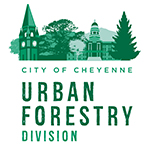


Have you checked your trees for girdling recently? Girdling happens when damage is inflicted all the way around the trunk of a tree where the bark has been chewed or stripped. This means the flow of nutrients and water to the tree has been interrupted. You have a serious problem if the tree bark has been removed and the damage extends to the phloem and cambium layers. These layers allow the flow of nutrients that keep a tree healthy (University of Minnesota Extension).
Many trees are girdled by human activity. Here are a few examples of common offenders that can lead to girdled trees:
1. Tree staking material such as rope, chain, arbor tie, guy wire, or any nylon or rubber ties.
2. Bird feeder hooks.
3. Nylon twine on a root ball.
4. Zip lines.
5. Clotheslines.
6. Christmas lights that are not removed.
7. Tree identification tags attached at the nursery.
If left on a branch or trunk of a tree to long and is failed to be removed quickly enough, can end up causing serious harm to your trees (José Fernández, Regional Manager, Russell Tree Experts).
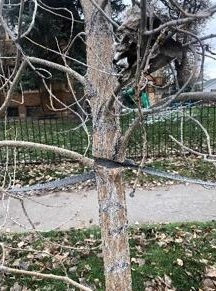 |
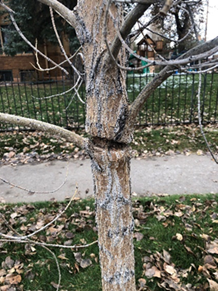 |
 |
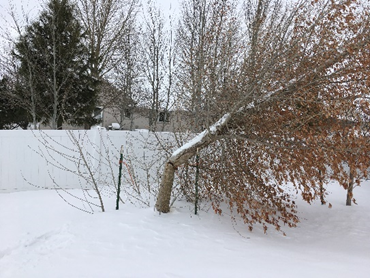 |
| *Here are a few examples of girdled trees. | |
Common Winter Tree Stem Damage:
Did you know that bark sometimes needs a little protection, especially in Cheyenne during the winter months. Bark is the tough armor that protects trees from outside stressors such as extreme weather and diseases. Sunscald and frost crack can threaten the health of our trees so we want to educate you on what you can do to help prevent bark damage during the winter months.
What is Sunscald?
Can occur anywhere from December through March when the high intensity sunlight heats up the south and southwest side of tree trunks. This causes cells in the phloem and cambium layer to come out of dormancy and become active. After sunset or as weather changes, temperatures may drop below freezing. This temperature drop kills active cells and conductive tissue. The impacted bark may crack or fall off in patches, revealing dead tissue underneath. Young, thin-barked deciduous trees, for example honey locusts, fruit trees, ashes, oaks, maples, lindens, and willows are at higher risk to be affected by sunscald. Sunscald is usually not fatal but young trees that have not fully developed bark could become damaged to the point of removal. Mature trees are less likely for sunscald to be life-threatening.
 |
 |
 |
| *The first two pictures are of sunscald on two different Norway Maple trees. The last picture is an example of sunscald on a Sensation Boxelder tree. | ||
What is Frost Crack?
Causes the inner layers of the bark to expand and shirk over and over during the winter months when there is a switch from warm to freezing temperatures. This tension eventually causes tree bark to crack. Frost crack more than likely shouldn't kill your trees, but it does invite in other stressors such as insects and diseases.
Sunscald and frost crack symptoms might not be obvious at first. In some cases, the outer layer of bark may not start to peel away until summer. Symptoms to look for include bark that is sunken, discolored, cracked, and or peeling.
 |
 |
| *Frost Crack on two different Sensation Boxelder trees. | |
How to protect young, smooth bark trees from sunscald and frost crack.
1. Water trees when it 40 degrees or above once a month during the winter months with 10 gal per 1 inch caliper!
2. Mulch trees to seal in moisture from tree watering. Add 2-4" thick donut shape of mulch around the tree to help retain moisture.
3. Wrap trees from November through April sort of timing, just when you have those potential for big temperature swings.
Wrap is available in different materials:
1. Polypropylene fabric
2. Paper product
3. Cardboard
4. Burlap
Use wrap as an insulator and protective layer to the bark underneath. Wrap trunks upward from the base of the tree to a point just above the lowest branches. Remember to remove tree wrap and tape the following spring to avoid girdling and possible insect damage. You may need to wrap trees each winter for several years until bark thickens and is less prone to sunscald damage. Smooth bark trees and younger trees are more susceptible to sunscald and frost crack, recommend wrapping them! Bigger, mature tree can take care of themselves because the bark is thicker and textured.
 |
 |
| *Example of tree wrapping from the Cheyenne Botanic Gardens. |
|
Trees that bear their seeds in cones are referred to as conifers. Most conifers have needle-like (spruce, pine, firs) or scale-like leaves (juniper) that they keep all year round. Conifers store carbon and provide habitat for many animals and organisms. They also provide us with shade, firewood, lumber, nuts, and berries.
Identify Coniferous Trees (pdf)
Looking for an outdoor project? Consider getting a head start on this year's yard work by pruning your trees. Winter is considered the best time of the year to prune, while deciduous trees are dormant. Properly pruning your trees in the winter will improve their structure and strength capabilities making them less susceptible to a late spring snowstorm.
Benefits of winter pruning include:
1. Unwanted branches are removed thus not drawing energy away from the rest of the tree.
2. Low temperatures prevent the spread of disease.
3. Winter pruning gives the tree an entire growing season to heal pruning wounds.
Large tree pruning should only be done by Certified Arborists; however, small trees can be pruned with a few essential tools and some knowledge of tree pruning. Necessary tools include 1. A hand pruner, 2. A hand saw, and 3. A step ladder.
Before pruning can begin, a basic understanding of how to make a pruning cut is necessary to prevent needless damage to the tree and encourage proper wound closure. Pruning cuts should be made just outside the branch bark ridge and branch collar. When pruning larger branches, the 3-cut method should be used to prevent the weight of the limb from tearing bark off the tree.

Now that you have the basics, pruning should begin by first making a visual inspection of the tree. All dead limbs, water sprouts, and suckers should be removed first. Next, identify the best leader and remove competing leaders. Finally, look for defective branches, such as rubbing or crossing branches and narrow angled branches.

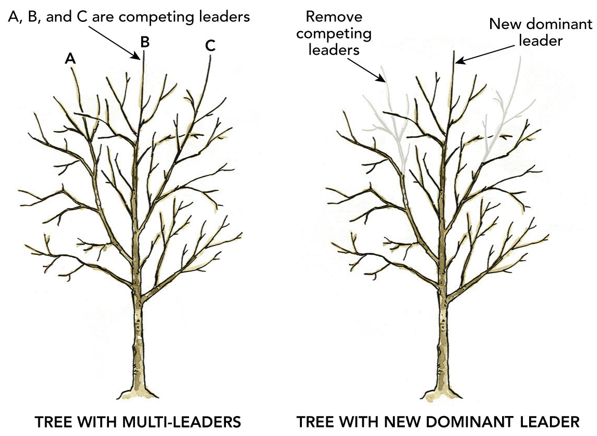
If necessary, now you can move on to thinning. Thinning is the selective removal of branches to increase light penetration and air movement through the canopy. Spacing lateral branches 8-12 inches apart in a young tree is a good rule of thumb. For questions regarding your tree pruning, please contact Cheyenne Urban Forestry at (307) 637-6428 or visit our websites https://rootedincheyenne.com/winter-pruning/ and www.cheyennetrees.com.
Winter Watering and Mulching (pdf)
Winter watering and mulching are very important for tree survival during the winter months. During the winter, trees lose their leaves and become dormant. With Cheyenne’s climate being so windy and cold, soil can become very dry to where it draws moisture out of tree roots. This causes serious damage to trees. It is extremely important to maintain good soil around the tree roots to ensure the health and well-being of trees during the winter months.
To help maintain good soil and overall health to trees, it is a good idea to water trees once a month in the winter whenever the temperature hits above 40 degrees. It is important to make sure there is no ice or snow on the ground near your trees. Early morning is the best time of day to water your trees. This allows time for the water to absorb before temperatures drop during the evening.
Placing a layer of mulch around your trees can also help hold in soil moisture. Adding 2-4 inches of organic mulch (bark, wood chips) over the root system will help preserve moisture and help keep the soil temperature warmer during the fall and winter months.
Newly planted trees along with evergreens are most susceptible to winter drought, so watering and mulching are critical activity to ensure the health of your trees.
To learn more about winter watering for your tree, please visit https://rootedincheyenne.com/winter-watering/ or call us at (307) 637-6428.
Winter Tree Watering Tips - Arbor Day Blog
Fall and Winter Watering - 7.211 - Extension (colostate.edu)
Winter Watering - Rooted In Cheyenne
winterize-trees-shrubs-fall-bb-2009.pdf (uwyo.edu)
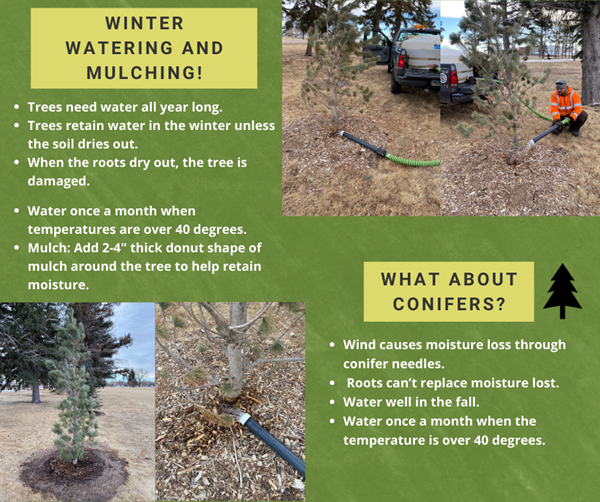
The tree house opened in 2005 and has been a popular attraction in Lion's Park. With decks at 4 feet, 8 feet, 10 feet, 12 feet, 16 feet and 20 feet high, the tree house provides a "bird's eye" view of life in the urban forest. Interpretive signs located on the four main decks of the tree house, provide information about the many parts of a tree.
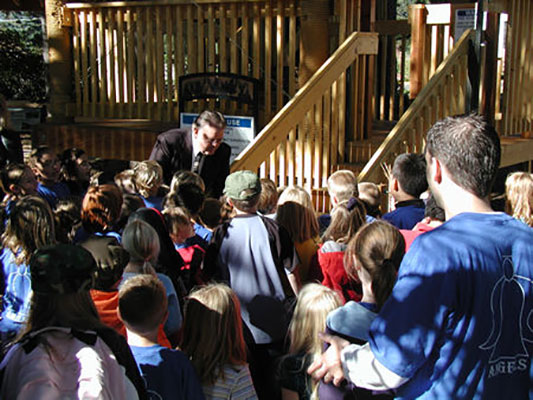
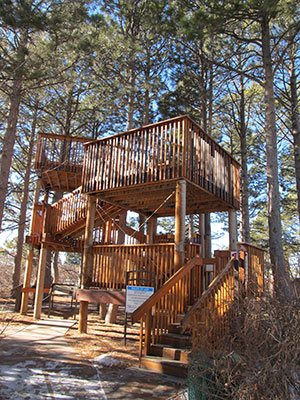
The tree walk is located in the southwest corner of Lion's Park and is a guided tour of 37 different tree species that are growing in the park. Guides are available free of charge at the Forestry office at 520 W. 8th Ave. These guides called "Trees of Lion's Park", include a map which identifies each of the trees on the walk and descriptions and comments about each tree. Additionally, drawings of the leaves and fruit of each tree are also included.
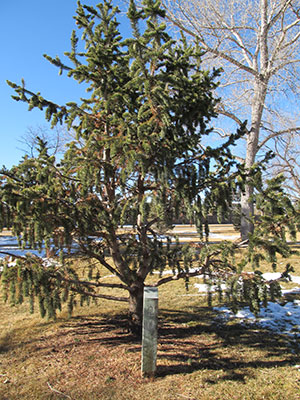
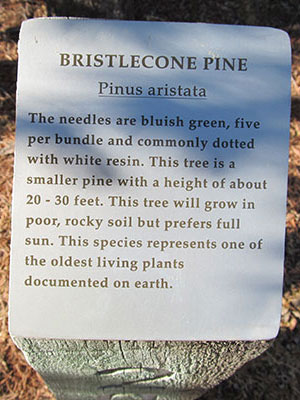
The High Plains Arboretum is located at the High Plains Research Station which is west of Cheyenne off of Round Top Rd. The research station began planting a large variety of trees, shrubs, fruits and vegetables in 1930 to determine which species were hardy to the high plains. To learn more about the history of the research station, click here. The arboretum sits on City property and is open to the public. The arboretum features over 60 different trees and shrubs from around the world and includes markers which identify many plants and gives brief descriptions, including country of origin and year planted. To view a map of the arboretum, click here.
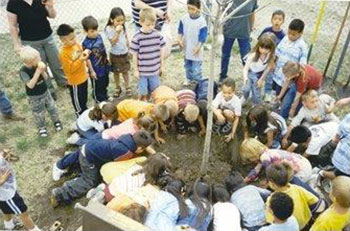
Winter Watering and Mulching (pdf)
Recommended Trees for Cheyenne
Caring for newly-planted trees
Trees for Wyoming
(courtesy of the Wyoming State Forestry Division)
Wyoming Tree Owners Manual
(courtesy of the Wyoming State Forestry Division)